
|
|

May 2, 2008
The Big Trip 2007, part I: Salt Lake City AMs
It's become an annual tradition here at Tower Site of the Week - load up the tape decks and the DVD recorders and the cameras, line up a bunch of station tours, gather a few friends, and hit the road for as much as two weeks of in-depth exploration of the radio and TV environment in some scenic part of this great nation of ours. Then we come home and share it all with you, in pictures here on fybush.com and in audio (of legal IDs) over at our sister site, tophour.com.
"Big Trip 2007" covered parts of Utah, Wyoming, Idaho, Montana, Washington and Oregon over two weeks in late August and early September, and we kick off our recap with several installments in which we explore the towers and studios and history of Salt Lake City and the Wasatch Front.
This is a market with much to recommend it to the intrepid tower hunter: as the only large market for several hundred miles, the region is home to a remarkable number of radio stations - more than two dozen AMs and a whopping 48 FMs serve this fast-growing area, which now sprawls for more than 60 miles almost without interruption from Provo in the south up to Ogden in the north.
In four days in Salt Lake City, we made it to nearly all of those AM sites, and this week we'll show you most of the AM towers in Salt Lake County, the core of the market. (We'll get to the Provo and Ogden areas, not to mention over the mountains to Park City and even Evanston, Wyoming, in upcoming episodes.)
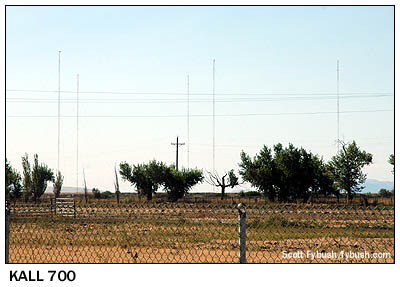
|
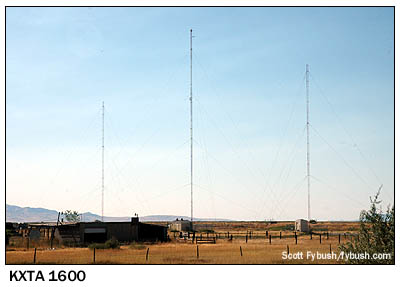
|
North of downtown Salt Lake, the valley narrows dramatically between the Great Salt Lake and the Wasatch Mountains, leaving just a narrow strip of suburbia along I-15 to divide the northern edge of the Salt Lake City metropolis from the southern edge of the Ogden area. It's no surprise that we find several AM signals taking advantage of the superb ground conductivity along the edge of the lake here, including one of the market's bigger signals. KALL (700 North Salt Lake) runs 50 kW by day and 10 kW by night from five towers just across the line in Davis County. While it's now a sports station, bearing heritage calls that long resided on Salt Lake's 910 AM signal, this was once KWLW, a sister station to the co-channel giant WLW in Cincinnati - and before that, it was KFAM, pumping beautiful music all over the West at night.
Just half a mile or so to the northeast of KALL (and directly adjacent to a massive construction project for the new Legacy Parkway project designed to relieve the bottleneck that is I-15 between Salt Lake and Ogden), Spanish-language KXTA (1600 Centerville) runs 5 kW days, 1 kW night from a three-tower array. (It changed calls to KTUB after our August 2007 visit.)
Heading south, just north of the I-15/I-215 split, we find another three-tower array, this one belonging to sports station KZNS (1280 Salt Lake City), with 10 kW days, 600 watts at night, and with a CP to move about a mile to the west and boost day power to 50 kW.
And continuing south into Salt Lake County on Redwood Road, one of the region's main north-south arteries, we find ourselves at the oldest site on this side of town, the widely-spaced two-tower array of KNRS (570 Salt Lake City). Historically known as KLUB, and later as KISN, this is now a Clear Channel talker (with a morning show hosted via ISDN by Rochester's own Bob Lonsberry, who has strong ties to the Salt Lake area), running 5 kW with a CP to boost day power to 50 kW, which will make this as potent a signal as the area offers, covering even more ground by day than the market's I-A clear channel KSL (1160).
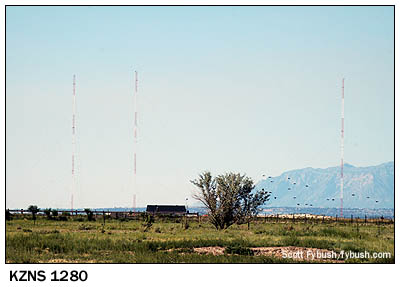
|
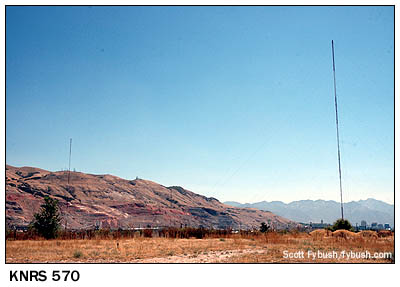
|
We'll devote a separate installment of Site of the Week to KSL, whose site sits at the southern edge of the Great Salt Lake, a dozen miles or so west of downtown Salt Lake City alongside I-80. Before we get there, though, we'll swing around the western edge of the city to show you some of the AMs out there.
Behind a truck stop out along Utah 201, we find the two towers of KCPW (1010 Tooele), which runs 50 kW by day and just 190 watts by night. This began as a local station, KTLE, on 990 in Tooele, out to the west behind the Oquirrh Mountains, then moved east as KIQN, and today it's a public radio station, sister to KCPW-FM (88.3 Salt Lake City) and KPCW (91.9 Park City), and while its intention was to bring KCPW programming to the outlying parts of Utah, it ended up being a financial drain on the KCPW/KPCW organization, which is in the process of selling its Salt Lake signals.
The 1010 signal used to come from another site closer to the airport, and when it moved here it began diplexing with another station, regional Mexican KMRI (1550 West Valley City), which runs 10 kW days, 340 watts at night from the left tower in the photo below. (The right tower was built new for KCPW a few years ago; the KMRI tower was built in 1997 when the 1550 station, then KRGO, moved from an older site to the east along Utah 201 (aka the 21st South Freeway).
Head east again toward Salt Lake City on that freeway, and just past Redwood Road we find two sites tucked into a rundown neighborhood. One, KSOP (1370 South Salt Lake), we'll explore in greater detail in a subsequent edition of Site of the Week; the other, the single tower shown below, is Citadel's KKAT (860 Salt Lake City). When we visited, its 10 kW day/196-watt night signal was carrying classic country; it's since flipped to the True Oldies Channel.
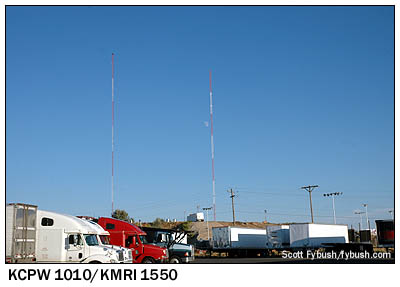
|
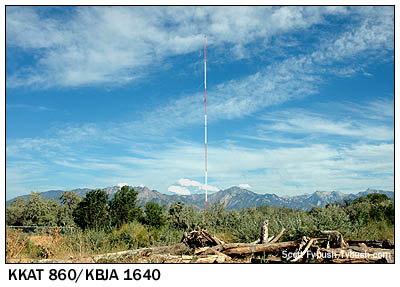
|
A mile or so south of KKAT, the former site of KTKK (630 Sandy) has been replaced by a housing subdivision, but another mile south along the Jordan River as it winds through the burgeoning suburbia of Taylorsville brings us to non-directional KJQS (1230 Murray), which broadcasts its ESPN sports programming from a site tucked in the woods at the corner of Murray Boulevard and Utah 174 (4800 South), not far from the southern juncture of I-215 and I-15.
So what happened to KTKK? The small locally-owned talk station is operating under STA from another site about eight miles to the south. That short tower is home to urban outlet KLLB (1510 West Jordan), running 10 kW days and 1 kW at night - but not for much longer. See that sign in front of the tower? It reads "STUB STREET IS NOT A DEAD END. IT WILL CONTINUE WITH FUTURE DEVELOPMENT." That means KLLB will eventually relocate to a new site at the western edge of the valley, where suburbia peters out into farmland and then into the copper mines in the foothills of the Oquirrh Mountains. And what happens to KTKK when the KLLB tower is replaced by more houses? It holds a CP to move way up north to the same neighborhood where KALL and KZNS are located; it would change city of license to Kearns, Utah when it moves there, still with less than a kilowatt of power.
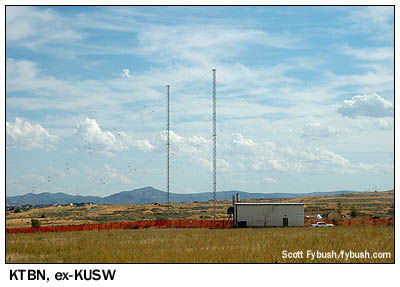 About
two miles south of the future KLLB site, we find another non-directional
AM, locally-owned standards station KDYL (1060 South Salt Lake),
which runs 10 kW by day and 150 watts by night from its site
alongside Utah 111 near the entrance to the Kennecott copper
mines. The KDYL calls date back to the earliest days of Salt
Lake radio, having been on the stations that are now KZNS 1280
and KFNZ 1320 before landing on the former KRSP(AM), which used
to have its studios and towers where the Jordan River crosses
Utah 173 (5200 South), just half a mile or so from the KJQS site.
About
two miles south of the future KLLB site, we find another non-directional
AM, locally-owned standards station KDYL (1060 South Salt Lake),
which runs 10 kW by day and 150 watts by night from its site
alongside Utah 111 near the entrance to the Kennecott copper
mines. The KDYL calls date back to the earliest days of Salt
Lake radio, having been on the stations that are now KZNS 1280
and KFNZ 1320 before landing on the former KRSP(AM), which used
to have its studios and towers where the Jordan River crosses
Utah 173 (5200 South), just half a mile or so from the KJQS site.
KRSP(AM), along with KRSP-FM (103.5 Salt Lake City), was a rocker owned by brothers Art and Ralph Carlson. In the late eighties, the Carlsons added a third signal to their portfolio: international shortwave station KUSW.
"From the West to the World," KUSW literally blanketed the nation from its site off 5400 West at the western edge of the valley - and for a few too-short years in the late eighties, it too was a rocker, programming a format that a later radio generation would describe as "rock-leaning AAA." It was over the airwaves of KUSW that your editor first heard Tracy Chapman's "Fast Car," and it was KUSW that provided a lone rock radio link to the outside world when your editor was living in an isolated desert valley in eastern California for a year. (Further evidence of just what a small world radio is arrived some 15 years later, when the former PD of KUSW surfaced in upstate New York and ended up working, briefly, alongside your editor, who was most grateful to acquire some airchecks of a station he'd never thought to record back in the day.)
Sadly, a commercial shortwave rock station proved to be a questionable business proposition (who'd have thought it?), and in 1990 the Carlsons sold KUSW to Trinity Broadcasting Network, which staged a record-burning at the station as the rock gave way to religion under new calls KTBN. As of March 30, 2008, KTBN has gone dark, ending the strange and fascinating life of this station, at least for the moment. (The Carlsons, incidentally, still own KDYL, though they sold KRSP-FM some years back.)
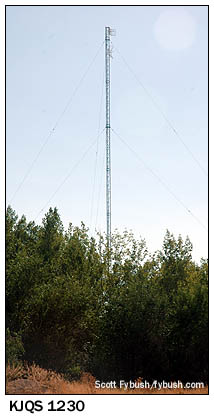
|
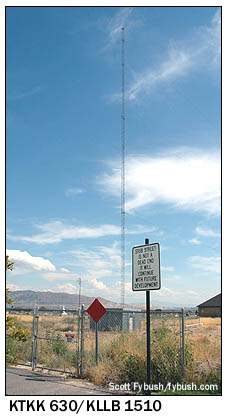
|
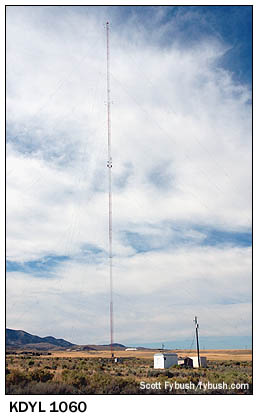
|
From KDYL, the highway bends back around to the east, becoming Utah 71 (12600 South, on the grid system that defines most addresses in Salt Lake County), and it's out here, near Riverton, that we find the county's southernmost AM station. KWDZ (910 Salt Lake City) is now a Radio Disney outlet, but its heritage is as KALL, one of the legendary top-40 stations here back in the sixties and seventies. Back then, 910 was part of the cluster of transmitter sites along the Jordan River, operating from a site just north of 1230 that's apparently now a golf course. It moved down here in 1990, and now runs 5 kW by day and 1 kW by night.
(Are you getting the impression that this would have been a much more interesting area to have visited, say, thirty years ago? Fortunately, my good friend John Johnson, aka "John in Montana," did just that, and his photos from the era can be seen here.)
There's one more AM of note out here on the south side of Salt Lake County: sports talker KFNZ (1320 Salt Lake City) was important top-40 outlet KCPX when it built its current two-tower site alongside I-215, just northeast of its southern juncture with I-15 and just a few blocks south of the old KRSP.
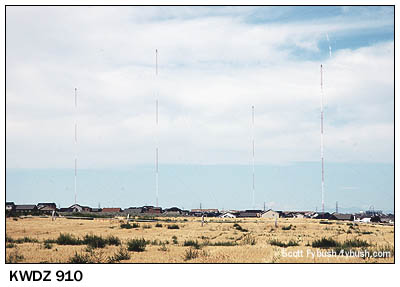
|
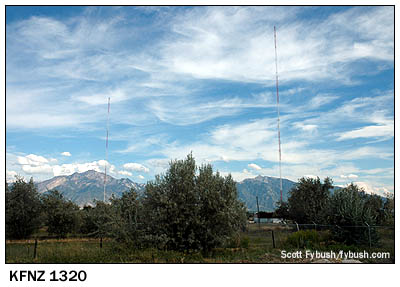
|
Before we head back to downtown Salt Lake to check out some of the major studio facilities, which we'll show you next week, we leave you this week with two of the small studios on the south side of town. KTKK is in a shopping center on Redwood Road in South Jordan, not far from the tower it's temporarily sharing with KLBB; KDYL is along the west side of I-15 not far from KTKK's old transmitter site.
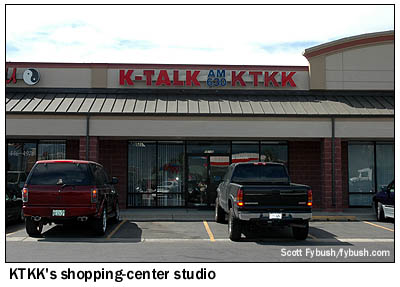
|
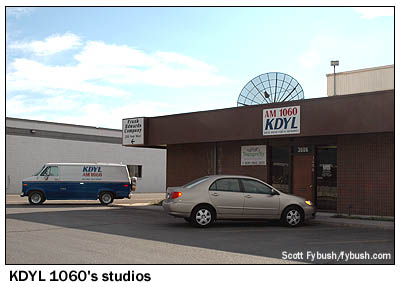
|
Want to hear what all these signals sound like? Join us Wednesday over at Tophour.com, where we'll start posting all the audio we gathered in Salt Lake and vicinity - and return here next Friday for part two of our Big Trip, where we get to see the valley's big voice, KSL, and much more, too!
Tower Site Calendar 2008 is almost sold out! Visit the Fybush.com Store now and get your calendar now!
- Previous Site of the Week: WKDM 1380/WWRU 1660, Carlstadt, NJ
- Next Week: Big Trip 2007 Part II - Salt Lake City
- Site of the Week INDEX!
- How can you help support Site of the Week? Click here!
- Submit your suggestions for a future Site of the Week!
